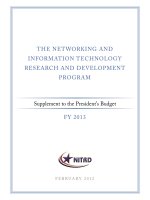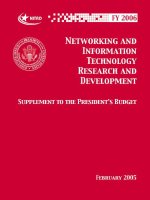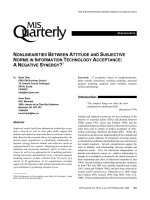information technology assignment 1 unit networking infrastructure
Bạn đang xem bản rút gọn của tài liệu. Xem và tải ngay bản đầy đủ của tài liệu tại đây (3.73 MB, 41 trang )
<span class="text_page_counter">Trang 1</span><div class="page_container" data-page="1">
<b>UNIT: NETWORKING INFRASTRUCTURE </b>
<b>STUDENT : NGO VAN TIN CLASS : SE06202 STUDENT ID : BD00325 </b>
<b>SUPERVISOR : NGUYEN BAO QUOC </b>
<b>Da Nang, June 2023 </b>
</div><span class="text_page_counter">Trang 2</span><div class="page_container" data-page="2"><b> ASSIGNMENT 1 FRONT SHEET </b>
<b>Unit number and title Unit 2: Networking Infrastructure </b>
<b>Submission date 15/6/2023 <sup>Date received (1st </sup></b>
<b>Re-submission date<sup>Date received (2nd </sup></b>
<b>sub-mission) </b>
</div><span class="text_page_counter">Trang 3</span><div class="page_container" data-page="3"><b>Summative Feedbacks: Resubmission Feedbacks:</b>
<b>Grade:Assessor Signature:Date:Internal Verifier’s Comments:</b>
<b>Signature & Date:</b>
</div><span class="text_page_counter">Trang 4</span><div class="page_container" data-page="4">1.2 Network Types ... 2
1.3 Protocol and Standardsu... 6
1.3.1 Network protocol definition: ... 6
1.3.2 Types of Network Protocol: ... 7
1.3.3 Some common Network Standards: ... 8
2. Explain the impact of network topology, communication, and bandwidth requirements. (P2) ... 8
2.1 Network topology. ... 8
2.1.1 Types of Network Topology ... 8
2.1.2 Examples of topology ... 9
2.2 Communications and Bandwidth. ... 16
3. Compare common networking principles and how protocols enable the effectiveness of networked systems(M1). ...17
3.2. Compare LAN, CAN, MAN, WAN ... 17
3.3. Compare physical topologies and logical topologies ... 18
3.4. Compare between OSI reference model and TCP/IP reference model ... 19
3.5. Compare TCP between UDP ... 20
CHAPTER 2 Explain networking devices and operations (LO2)... 201. Discuss the operating principles of networking devices and server types.(P3)
20
</div><span class="text_page_counter">Trang 5</span><div class="page_container" data-page="5">2.3. Explain what is meant by interdependencies ... 34
2.4. Give examples of interdependency ... 34
2.5. Discuss and explain the interdepence of workstation hardware with networking software. Derive an example form your discussion ... 34
3. Explore a range of server types and justify the selection of a server, considering a given scenario regarding cost and performance optimization(M2). ... 35
</div><span class="text_page_counter">Trang 7</span><div class="page_container" data-page="7">INTRODUCTION
</div><span class="text_page_counter">Trang 8</span><div class="page_container" data-page="8">CHAPTER 1 EXAMINE NETWORKING PRINCIPLES AND THEIR TOCOLS(LO1)
PRO-1. Discuss the benefits and constraints of different network types and standards. (P1)
1.1 Define Network
A computer network is a system that connects many devices to share resources and communicate with each other. It enables data transmission and sharing of information between devices. It is done within the network, regardless of their physical location.
Figure 1.Computer network[1]
1.2 Network Types
- A local area network (LAN) is a collection of devices that are interconnected at a physical location, such as a building, office, or home. LANs can be small or large, from a home network with users to a business network with rows of users and devices in the office or school.
</div><span class="text_page_counter">Trang 9</span><div class="page_container" data-page="9">Figure 2.Local area network(LAN) [2]
Benefits:
Simple and Inexpensive: The main benefit of a Local Area Network is that it is quick and easy to set up for a relatively low price. If an organization wants to build a network at a low cost and flexibility, a local area network would be an ideal choice.
Accessible Software: Programs can also be shared on the Local Area Network. Combine a single licensed program and any device can use it on the network. Fast communication: Devices linked to the LAN transfer files and communicate di-
rectly and quickly based on the LAN model and installed ethernet cable. They work on 1000 Mbps, 100 Mbps and 10 Mbps. Gigabit Ethernet technology is evolving rapidly. If the technology becomes complex and mass-produced, lower-cost vari-ants will become accessible to the masses.
Client and Server Association: All company related information is kept on one server. If a customer requests information, the customer can seamlessly access that information.
Resource collaboration: Expensive components, like scanners and printers, cannot be connected to every device in the office and it becomes a heavy task for the or-ganization, but in a LAN, requires a printer and scanner. and people can be con-nected and they have to send instructions from their respective machines. This will save staff time and money.
File Locking: A LAN allows locking files within its network. Drawbacks:
Weak data protection: Unauthorized users can access files if the server has not been programmed properly. Therefore, malfunctions are frequently observed. Maximum Damage: If a device, file, or server goes down, it affects the entire net-
</div><span class="text_page_counter">Trang 10</span><div class="page_container" data-page="10">Maintenance: LAN requires frequent maintenance and the involvement of cians and system operators.
Space Issues: LAN software requires an area of memory in each mainframe used on the network. It minimizes the space required for the user's program. - Wide area network (also known as a WAN) is a large information network that is
not constrained to one location. A WAN can facilitate communication, information sharing, and more between devices from around the world through a WAN provider.
Figure 3.Wide area network(WAN) [1]
Benefits:
Share Resources: The primary benefit of WAN is the ability to connect multiple fices, branches, and data centers around the world. This enables businesses to share resources, data, and applications with each other, eliminating the need for expensive and time-consuming physical connections between each location Scalability and flexibility: A WAN can easily scale up to meet increased bandwidth
of-requirements in a short period of time. This means that organizations can instantly increase bandwidth as needed without having to install new equipment.
Cost reduction: A WAN is significantly less expensive to implement than a private network. This makes WANs cost-effective for connecting remote offices and in-creasing bandwidth.
Improved security: Data transmission across a WAN is more secure than based transmission because most WANs use public networks.
</div><span class="text_page_counter">Trang 11</span><div class="page_container" data-page="11">Acess to a wide range of service: Since WANs use the internet, organizations can access a wide range of networks and services.
Drawbacks:
Increased latency: Since data is transmitted over a WAN, there may be an crease in latency. This means that it may take longer for data to travel across the network.
Higher costs: Because WANs use a public network, they may come with a higher price tag than a private network.
Security risks: While WANs are generally more secure than LANs due to the use of TLS, there are still some security risks. For example, employees may not use TLS properly, which can open the network to hacking.
Slower Issue: WANs are often slower than LANs due to the increased distance tween locations. This can affect the performance of applications and services that are hosted on the WAN.
Complexity: WANs require complex network configurations and specialized ware, which can be difficult to set up and maintain. Additionally, WANs are vulnera-ble to outages and disruptions due to their reliance on the public Internet. This can cause data to be lost or delayed, which can be costly for businesses
hard-- The term MAN full form is a metropolitan area network. It is in between LAN and WAN technology and that cover the entire city. It is very similar to LAN technology. Here this article gives information about the advantages and disadvantages of MAN to know more details about it.
</div><span class="text_page_counter">Trang 12</span><div class="page_container" data-page="12">Figure 4.Metropolian area network(MAN)
It is difficult to secure the network once its becomes large
Network installation require skilled technicians and network administrators. This increases overall installation and management costs
Cost is higher than LAN
While we move our network to another city or area it doesn't work 1.3 Protocol and Standardsu
1.3.1 Network protocol definition:
Network protocols are a set of rules outlining how connected devices communicate across a network to exchange information easily and safely. Protocols serve as a common language for devices to enable communication irrespective of differences in software, hardware, or internal processes.
</div><span class="text_page_counter">Trang 13</span><div class="page_container" data-page="13">Figure 5. Network protocol
1.3.2 Types of Network Protocol:
Different protocols serve different functions to ensure efficient, quick, and secure work communication. Various types of network protocols can be categorized into the following three broad categories to help organizations operate seamlessly across dif-ferent business scenarios:
net-- Network Communication Protocols: These protocols determine the rules and formats to transfer data across networks. Communication protocols govern various aspects of analog and digital communications, such as syntax, authentication, semantics, and er-ror detection, among others. Some key network communication protocols include: Hyper-Text Transfer Protocol (HTTP)
Transmission Control Protocol (TCP) Internet Protocol (IP)
User Datagram Protocol (UDP) File Transfer Protocol (FTP)
- Network Security Protocols: These protocols ensure safe data transmission over the network connections. Network security protocols define the procedures to secure data from any unauthorized access. These protocols leverage encryption and cryptography to safeguard. Here are the most widely used network security protocols:
Secure File Transfer Protocol (SFTP) Hyper-Text Transfer Protocol Secure (HTTPS) Secure Socket Layer (SSL)
- Network Management Protocols: Network managers require standard policies and procedures to manage and monitor the network for maintaining smooth communica-tion. Network management protocols ensure quick troubleshooting and optimal perfor-mance across the network. The following are essential network protocols manage-ment:
Simple Network Management Protocol (SNMP)
</div><span class="text_page_counter">Trang 14</span><div class="page_container" data-page="14">Internet Control Message Protocol (ICMP) 1.3.3 Some common Network Standards:
- International Organization for Standardization (ISO) - Wi-Fi Alliance (WFA)
- International Telecommunication Union (ITU) - Internet Society (ISOC)
- Storage Networking Industry Association (SNIA - IT Infrastructure Library (ITIL)
- European Union (EU)
2. Explain the impact of network topology, communication, and width requirements. (P2)
sev-Each network structure model diagram is the basis for network administrators to tor and support the maintenance and repair process of the network system.
moni-2.1.1 Types of Network Topology
The structure a network can directly impact its functioning. Therefore, companies ofmust select the most suitable topology for their network bolster performance and toenhance data efficiency. The right topology also optimizes resource allocation and minimizes operational costs.
Organizations use network topology to define how their network nodes are linked to each other. The two major categories of topology are physical and logical. Physical Topology refers to the interconnected structure of a local area network
(LAN). The method employed to connect the physical devices on the network with the cables, and the type of cabling used, all constitute the physical topology. This contrasts with logical topology, which describes a network’s media signal perfor-mance and how it exchanges device data.
Logical network topology is not always mapped to a specific physical topology. For example, twisted pair Ethernet is logical bus topology that is mapped to a physical star topology plan, while IBM’s token ring is a logical ring topology that is physically implemented as a star topology.
Logical topology is a concept in networking that defines the architecture of the munication mechanism for all nodes in a network. Using network equipment such as routers and switches, the logical topology of a network can be dynamically main-tained and reconfigured.
</div><span class="text_page_counter">Trang 15</span><div class="page_container" data-page="15">com-Logical topologies contrasts with physical topologies, which refer to the physical terconnections of all devices in the network.
in-The logical topology defines how the data should transfer. Contrast this to the cal topology, which consists of the layout of cables, network devices and wiring.
physi-2.1.2 Examples of topology
Some common physical network topologies used by organizations include point to point, bus, ring, star, tree, mesh, and hybrid topology networks. Each type consists of different node and link configurations.
Point to point topology
Point to point is a simple topology that directly links two nodes and reserves the tire bandwidth of the connection for them to communicate with one another. Physi-cally, point- -point connections rely on a cable or wire that connects the two end-topoints. However, logical topological connections using satellite links and micro-waves are more common nowadays.
en-Figure 6. Point to point
A basic example of a point- -point connection is changing the temperature of an air toconditioning unit using a remote control.
Bus topology
In a bus topology, all the nodes are linked using a single cable with a terminator on both ends. This configuration sees one main cable acting as the backbone for the whole network.
</div><span class="text_page_counter">Trang 16</span><div class="page_container" data-page="16">Figure 7.Bus topology
In such an arrangement, the server node transmits data from one end of the cable and in a single direction to the client node. As the data travels to each node, its des-tination address (MAC/IP) is checked to see if it is received and processed. If there is a mismatch in the address, the node does not do anything with the data. This way, only the node that recognizes its address uses the data that travels on the single cable, while the other nodes are unaffected. Once the data reaches the end of the cable, the terminator removes it to prevent signal bouncing Ring topology
In a ring topology, each node is linked with its neighbor to form a closed network. This configuration sees the data move from one node to another, either unidirec-tionally or bidirectionally. Such network topology is used in smaller networks, like those in schools.
</div><span class="text_page_counter">Trang 31</span><div class="page_container" data-page="31">Never filter data
Costly and difficult to manage
Protocol conversion is performed, thus resulting in a slower transmission rate. f. Modern
In regards to networking (network devices modem), a modem is a piece of hardware that enables a computer to transmit and receive data over telephone lines. In a nutshell, a modem is a piece of hardware that connects a computer or router to a broadband network.
</div><span class="text_page_counter">Trang 32</span><div class="page_container" data-page="32">Figure . MODEM20
When a signal is sent, the device converts digital data to an analog audio signal and sends it over a phone line. Similarly, when an analog signal is received, it is converted back to a digital signal by the modem. Onboard modems, internal modems, external modems, and removable modems are all examples of modems. A modem operates at the OSI model’s physical layer (Layer 1) or Data link layer (Layer 2), depending on the type.
Advantages:
Easily allows connecting LAN to internet Converts digital signal into an analog signal When compared to the hub, the speed is slow
</div><span class="text_page_counter">Trang 33</span><div class="page_container" data-page="33">Figure . REPEATER 21
A range extender or wireless repeater, for example, is a repeater that extends the range and strength of a Wi-Fi signal. A repeater is effective in office buildings, schools, and factories where a single wireless router cannot reach all areas. A re-
peater operates at the OSI model’s physical layer (Layer 1). Advantage:
Repeaters are simple to set up and inexpensive. Repeaters do not necessitate any additional processing. They can connect signals with various types of cables.
Disadvantage:
Repeaters are unable to connect disparate networks.
They are unable to distinguish between actual signals and noise. They will not be able to reduce network traffic.
h. Access Point.
In terms of networking, an access point (AP) is a wireless network device that acts as a portal for devices to connect to a local area network. Access points can extend an existing network’s wireless coverage and increase the number of users who can connect. Wireless access points (WAPs) are devices that combine a transmitter and receiver (transceiver) to form a wireless LAN (WLAN). The access point operates at the OSI model’s Data Link layer (Layer 2).
</div>








